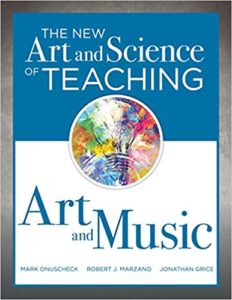The Art and Science of Teaching Art and Music
The New Art and Science of Teaching Art and Music
By Mark Onuscheck, Robert J. Marzano, and Jonathan Grice
(Solution Tree Press, 2020 – Learn more)

Is teaching a science? Is teaching an art?
Dr. Robert J. Marzano, cofounder and chief academic officer of Marzano Resources, first sought to settle this debate with his seminal work, The Art and Science of Teaching, in which he declared that teaching is not an art or a science but rather both.
Ten years later, armed with new research, he greatly expanded this work and released it as The New Art and Science of Teaching.

Together they have developed what will surely become the go-to resource for planning, designing, implementing, and assessing the teaching of art and music, using Marzano’s latest teaching framework.
Feedback, content, and context
The New Art and Science of Teaching Art and Music is organized based on the aforementioned framework, which consists of three broad categories: feedback, content, and context.
Within these categories are ten design areas:
- providing and communicating clear learning goals,
- using assessments,
- conducting direct instruction lessons,
- conducting practicing and developing lessons,
- conducting knowledge application lessons,
- using strategies that appear in all types of lessons,
- using engagement strategies,
- implementing rules and procedures,
- building relationships, and
- communicating high expectations.
Drilling down even further, the framework describes forty-three elements in all. (A chart of the categories, areas, and elements can be found on page five of this book or page eight of Marzano’s 2017 text.) Each chapter is based on one of the design areas, with explanations of how the elements can be implemented through the use of hundreds of strategies.
Stresses strategies that have the greatest impact
While it is clear that the authors have conducted thorough research in preparation for publishing this book, it is not overly burdened with research methods, data tables or references. Rather, the research is referenced with sufficient detail to support the claim and is then followed-up with practical application. (Those who wish to dig deeper into the research are able to consult thirty-six references listed at the end of the book.)
The authors make very clear from the beginning that this work does not represent an exhaustive description of every instructional strategy a teacher could use; rather, these are the strategies that are likely to have the biggest impact.
Ideas for educators beyond art and music
Although this is a book clearly written for the benefit of art and music teachers, there are suggestions throughout that could be used by any educator, whether by using portfolios to help students track progress over time; guiding students to move past imitation when creating; establishing rules, procedures, and expectations as a class; or by incorporating art and music in every classroom setting early and often.
That being said, art and music teachers will be delighted to find a text that was written with them specifically in mind. Each instructional element description is accompanied by a detailed list of practices that are unique to the art classroom, the music classroom, or, in some instances, both.
In closing their book, the authors make this bold statement: “It is the duty, the call to action, and the mission of educators everywhere to meet students where they are and elevate them to the next level of learning.” I do not believe it is an exaggeration to say that The New Art and Science of Teaching Art and Music will help every art and music teacher to accomplish just that.
Alex T. Valencic, Ed.M., is the Curriculum Coordinator for 21st Century Teaching and Learning in Freeport, Illinois. He has taught professionally for over ten years. When not working with K-12 teachers who are implementing project-based learning and other innovative strategies to support students, Mr. Valencic can likely be found reading, hiking, or spending time with his family and friends playing tabletop games. You can learn more about his adventures in teaching fourth grade by visiting his blog Adventures in the 21st Century or by following him on Twitter @alextvalencic. This is his eleventh book review for MiddleWeb.


































